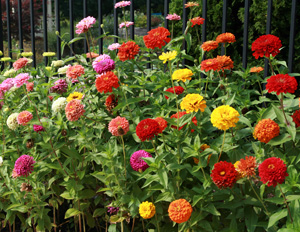
The National Garden Bureau has declared 2011 the “Year of the Zinnia”. These annual flowers (along with tomatoes) were chosen because they are popular, easy-to-grow, widely adaptable, genetically diverse and versatile.
Zinnias are one of the most popular bedding plants world-wide. The 13 species in the genus Zinnia are all native to Mexico and adjacent areas and many have been used to develop a diversity of different types of ornamental plants. Ranging from 8″ mounds to rangy 3-4 foot tall bushes, and with flowers in a rainbow of colors, there is something for everyone among the hundreds of cultivars and hybrids that are now available. Flowers may be single, double or semi-double to produce blooms that look like dahlias, cactus flowers, or beehives.
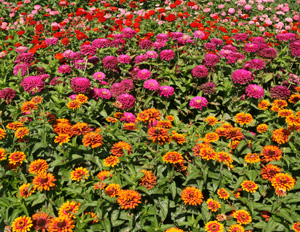
With large seeds that germinate quickly into rather sturdy plants that require little care, zinnias are often suggested as a good crop for children and beginners. They are fairly quick to flower and provide long-lasting color throughout the summer. Zinnias thrive in hot conditions, are attractive to butterflies, and most make excellent cut flowers.
Zinnias do best in full sun, in well-drained soil. They can be seeded directly where you want them to grow once the soil warms, or young transplants can be set out to get a jump on the season. You can include them in borders, annual beds, mixed beds or cutting gardens. Many cultivars work wonderfully in containers, while the taller types make a good backdrop for shorter bedding plants.
Many zinnias are affected by powdery mildew, especially when humid conditions prevail. Spacing to allow plenty of air circulation will help reduce this problem, and these days there are some resistant varieties to choose from.
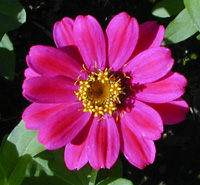
Zinnia elegans is a tall, upright type with wide, coarse leaves and large flowers. Z. angustifolia (narrow-leaf zinnia) is a low-growing species with flower color limited to orange, yellow and white. These two species have been crossed to create the popular ‘Profusion’ and ‘Zahara’ series, as well as other hybrids that exhibit some of the best traits of both parents (given the species name Z. marylandica because they were developed at the University of Maryland).
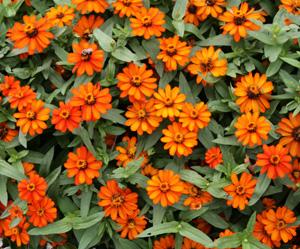
The ‘Profusion’ Series offers compact plants in a variety of bright colors. They come in a cherry or rose color (a 1999 AAS winner), orange (also a 1999 AAS winner), white (2001 AAS winner, as well as winner of the AAS Gold Medal Flower Award), and other colors including apricot and the two-tone ‘Fire’. The plants are rather low-growing, only getting 12 inches high, but branch readily with dense, narrow leaves, spreading about 15 inches wide. They are covered with small, single flowers all season long. What makes these plants extra special is that they are highly tolerant of mildew and other foliage diseases. They’re great along the edge of plantings with taller annuals or perennials behind them, and work well in containers.
The ‘Zahara’ series is another great option for the garden. These plants are also award-winning, disease resistant cultivars but have larger flowers and come in a wider range of colors, as well as offering double flowers in some colors. ‘Double Zahara Fire,’ ‘Double Zahara Cherry,’ and ‘Zahara Starlight Rose’ were 2010 AAS winners, but there are also coral rose, scarlet, yellow and white in the series.

Another cultivar that may become an instant favorite is Z. elegans ‘Zowie! Flame Yellow’. This 2006 AAS winner is a semi-tall (2-3 feet) cultivar with a unique bicolor flower pattern. The promotional literature states that it has a scarlet-rose center and yellow petals edges.
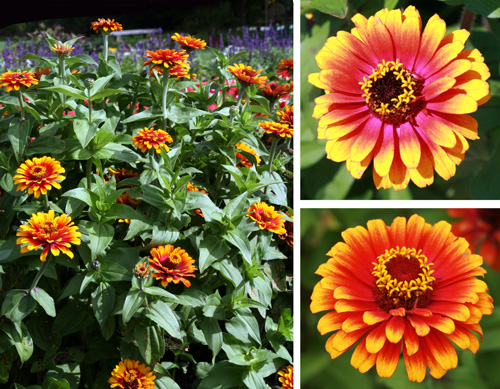
As the 2-5″ layered, semi-double blooms age they become more of a rich red and yellow, but still very attractive. The plants can be very florific and may produce plenty of blooms right up to frost. Plant them in drifts in a mixed garden, interspersed among tall ornamental kale (such as blue-green ‘Nero Di Toscana’ and purple ‘Redbor’), and clumps of ‘Purple Majesty’ ornamental millet. Fill the spaces between all of the plants with airy sprays of purple Verbena bonariensis, which is a great combination with the yellow and red zinnia flowers.
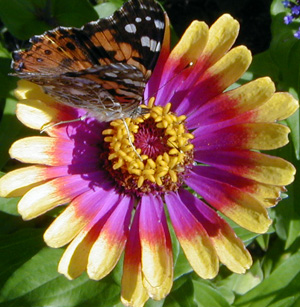
Another bicolor zinnia option is ‘Sombrero’. This older variety of Z. haageana may not be readily available these days. The single blooms have deep red centers and defined yellow petal tips. This is a shorter cultivar, growing only 15-18″ tall.
– Susan Mahr, University of Wisconsin – Madison





 Marigolds
Marigolds Create a Butterfly Garden
Create a Butterfly Garden Plant Flowers to Encourage Beneficial Insects
Plant Flowers to Encourage Beneficial Insects Forcing Bulbs
Forcing Bulbs


